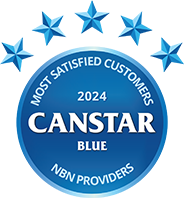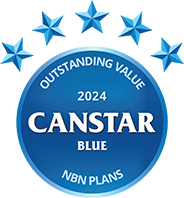Choosing the best NBN plan can be a bit daunting, especially considering the sheer number of providers and plans out there, and the confusing jargon and plan structure. Generally, you need to look out for the right combination of these three things:
Residential customers now have the choice of six NBN speed tiers, but availability will depend on your NBN connection type. While it’s natural to want the fastest plan possible, NBN plans are also priced by speed tier, so faster speeds mean a bigger bill – so you’ll want to make sure you’re on the right plan for your needs and your budget.
The most popular speed in Australia is NBN 50, which offers a maximum download speed of 50Mbps, plus upload speeds of up to 20Mbps. This speed is suitable for moderate to heavy internet users, and is fast enough to support HD video streaming, online gaming and video calling for three to four people simultaneously.
Basic users may prefer the cheaper NBN 12 or NBN 25 tiers, while large households on eligible NBN connections may also want to look at NBN 100, NBN 250 or even NBN 1000, if you’re happy to pay more for ultra-fast speeds.
It’s hard to pick a single fastest NBN provider, but some telcos do typically out-perform many of their competitors when it comes to average download or upload speeds. A good indicator is the ACCC’s quarterly Measuring Broadband Australia report, which looks at the average performance of the most popular NBN providers in the country.
The ACCC’s report in December 2024 listed Exetel as the strongest performing telco for the first time, but other consistently-fast providers include TPG, Telstra and Optus. This report looks into how close to the maximum available speed each provider’s plans typically come during high-traffic periods, and how well telcos handle high-bandwidth activity such as HD video.
Canstar Blue also includes speed and reliability as a factor in its yearly NBN Providers Ratings, which are based on feedback from thousands of NBN customers. In our 2024 ratings, winning provider Aussie Broadband was awarded a full five-star score for speed, along with Exetel and iPrimus, while the remaining providers scored four or three stars.
Each NBN speed tier offers a maximum download and upload speed, although your real-world performance may not be quite as fast. You may also find that you’re sometimes hitting speeds slightly over the advertised maximum, as NBN Co will sometimes over-provision capacity on certain tiers during busy periods. During lower traffic periods, such as very late at night, you’ll typically experience faster speeds due to less people using the network. In peak hour times (between 7pm and 11pm), your speeds will likely slow down somewhat, but a good plan should still deliver at least 90% of the potential maximum speed available. Here’s what we think a ‘good’ internet speed in Australia is.
If you’re looking for a busy hour performance, you’ll want to also check your intended telco’s listed Typical Evening Speed (TES). This is the average speed users will experience during peak periods (between 7pm – 11pm) and is generally the most accurate indicator of how fast your service will actually be.
There are many factors that can impact your NBN speed, including congestion in your area, the plan and provider you opt for, your location and connection type, and even the modem you’re using. Aside from changing your provider or plan, some DIY tricks to improve your internet speed include using WiFi extenders or mesh networks, switching off your VPN, upgrading your modem/router, and repositioning your modem for a better connection.
Test how fast your internet speed is with our free tool
Every Aussie household wants a reliable connection that won’t drop out or slow down, but the average internet bill does vary between families and individuals. If you’re on a tighter budget, you may be limited in terms of the maximum speeds you can comfortably afford each month. In contrast, if you’re a heavy video streamer or a big online gamer, you may be happy to pay a little extra for a faster plan.
If you’re looking for the lowest monthly cost, the cheapest NBN plans are usually found on the entry-level NBN 12 speed tier. We update our database daily so you can compare the cheapest NBN plans available right now.
At Canstar Blue, we have designed an expert ‘Value Rank’ methodology to determine the best value NBN plans available in Australia right now, based on a combination of price and features.
If you’re not a heavy data user, or just need a basic plan for occasional web browsing and emails, you may benefit from a capped data plan. This means that instead of unlimited data, your monthly usage will be restricted to anywhere from 10GB to 500GB, depending on your plan and provider, with any excess data usage normally ‘throttled’ to slower speeds, typically around 1Mbps.
This can be a good way to shave $10-$15 or more each month off your NBN plan, but be aware that most providers do tend to offer unlimited data as standard. Telcos who do sell capped data options, especially for cheaper speed tiers, include TPG, Aussie Broadband and iiNet.
Many NBN providers offer add-ons such as home phone, optional modems, and even added streaming entertainment like Netflix or set-top boxes (for example, Fetch TV or Hubbl). Other extras that may be available with your plan include home internet security and anti-virus packages, WiFi extenders, and mobile phone or energy bundles; what’s available to you will depend on your provider and choice of plan.
As noted above, some telcos do offer customers mobile phone and NBN plan bundles, and discounts may be available for combining both products under one account. Most of the big-name NBN providers also sell mobile phone SIM plans in addition to home internet, so you may be able to save on your combined bills by bundling (as long as you’re on a phone and internet plan that’s right for your needs and budget).
The performance and potential speed of your NBN plan will depend on the NBN connection type available at your address. This refers to the type of NBN technology used to connect your home to the NBN network. Some of the main connections available to Australians are below.
You can find your home’s NBN connection type via NBN Co’s website, or by entering your address in your NBN provider’s address check tool.
Previously, NBN Co offered customers the choice to upgrade to a faster FTTP connection via its Technology Choice Program; however, this was a complicated and expensive process. NBN Co has since begun rolling out free FTTP upgrades to more than three million eligible addresses that can currently only access FTTN or FTTC. Check NBN Co’s website to see if your address is eligible.
If you’re unable to get reliable or fast NBN at your home, there are a range of NBN alternatives available. Depending on your location, you may have access to options such as non-NBN fibre networks (such as OptiComm or GigaComm), 4G or 5G home internet (also known as home wireless broadband), or mobile broadband. Regional customers may also be eligible for Starlink satellite internet.
Each year, Canstar Blue surveys thousands of NBN users to determine which NBN provider offers the best customer satisfaction.

Aussie Broadband was a back-to-back winner in our 2024 Most Satisfied Customers award for NBN providers, scoring five stars across almost all categories, except value for money and ease of setup, where it scored four stars.
Canstar Blue’s Outstanding Value Award is based on our unique value rank methodology, and highlights NBN providers offering superior value and features.

Our 2024 award for Outstanding Value NBN plans goes to Tomi, which previously won for fast-speed NBN plans. It offers a range of competitively priced plans with added value, along with a range of speeds to suit different household needs.

Taking out our 2024 award for Outstanding Value High-Speed NBN plans is Superloop. This fast-growing provider offers cheaper pricing with higher download speeds, along with competitive features like free speed boosts and discounts.

Keep in mind that while there are the big internet companies which have a large portion of market share, there are plenty of smaller providers to choose from. Looking at offers from a range of telcos, both the big and small names, will help you to find the best solution for your home.
If you’re already on an NBN plan, but want to move to a different provider, switching is simple.
You’ll need an NBN-compatible modem to connect, so if you’re using an older piece of hardware you’ll most likely need to upgrade. The exact type of modem you need may depend on the technology used to supply NBN to your home, but your NBN provider can advise you what kind of modem/router is suitable for your plan at sign-up (and often supply it to you directly, either included in your plan price or as an additional purchase).
If you’re on a month-to-month plan, you should be able to cancel your plan at any time without incurring any early termination costs – simply pay out your final NBN bill, and you’re free to go. However, some providers may hit you with modem charges if you leave within 12, 24 or 36 months, even without a contract — for example, Telstra, Optus and Vodafone each include a modem with NBN plans, but it’s only ‘free’ if you stay connected for a minimum period.
If you are on a contract, you may be subjected to an early termination charge, which is calculated based on the remaining months you have left on your plan.
 Tara Donnelly: Utilities Editor
Tara Donnelly: Utilities EditorAs Canstar Blue’s Utilities Editor, Tara Donnelly covers the electricity, internet and mobile sectors – topics she’s spent a decade focused on, alongside consumer technology, within the comparison industry. Her telco expertise has seen her appear in national media including 9 News, 7 News, Sunrise, the ABC and The Sydney Morning Herald.
Meet the Editorial Team

Josh Filosi is Canstar’s Data Insights Analyst, and helps develop and deliver the methodology for Canstar Blue’s Value Rankings and Awards for the telco industry. He holds a double-major in Economics and Behavioral Science, and enjoys interpreting complex data. Connect with Josh on LinkedIn.
Meet the Research TeamThe National Broadband Network (NBN) is a fixed line and wireless internet network that is now available to the majority of Australian homes and businesses. Operated by NBN Co, the network uses fibre, fixed wireless and satellite connections to replace the existing copper wire networks used in ADSL, and offers faster download and upload speeds that are better suited to how we use the internet today.
If your home is NBN-ready, you can buy an NBN plan from an internet service provider (that’s telcos such as Telstra, Optus, or TPG). Although NBN Co owns and manages the NBN, it doesn’t sell directly to consumers; instead, you’ll need to buy a plan through an ISP, but this means you can shop around to find the best deal.
To check if you’re eligible to connect, you can enter your address at NBN Co’s website, or with your prospective ISP/NBN provider at sign-up. There are dozens of providers who sell NBN plans to residential customers, and multiple speed tiers available – so comparing NBN plans before you commit is a great way to find the best price and speed for your home.
The good news is that a standard NBN installation is free, with all costs covered by NBN Co. However, there is an exception if you’re in a new development area, and you may be required to pay a New Development Fee of up to $300; however, you’ll be informed if this applies to you before your order is finalised.
If you’ve scheduled an installation time but need to cancel, you may incur a cancellation fee depending on your telco and the amount of notice you give. You should also keep in mind that while installation is generally free, you may be required to pay activation or setup fees to your NBN provider, or pay upfront modem costs if you need to buy hardware.
If this is the first time NBN has been connected at your address, it’s likely that an NBN technician will be required to install and activate your service. Your NBN provider will advise you at sign-up if this applies to your home, and arrange a time for your installation to be completed (so you won’t need to contact NBN Co directly to make an appointment).
If you’re looking for a faster, more reliable broadband plan that is ‘future-proofed’ (rather than relying on old copper networks), the NBN is likely worth the effort. Despite the NBN’s initial teething problems, most customers are generally happy with their service and speed post-NBN rollout, and the huge range of plans on offer make it easier than ever to find an option to complement your needs and budget.
Of course, experiences will vary, which is why you may want to compare NBN providers across independent metrics (such as Canstar Blue’s Most Satisfied Customers – NBN Providers ratings) before committing to a plan.
For seniors and pensioners, you might have different internet needs compared to other households. Not only that, but you might also want to see if you can get any special deals or discounts on your internet bill if you hold an eligible seniors card.
Some NBN providers do offer special discounts and deals to seniors, while other telcos might offer some cheap NBN plans on slower NBN speed tiers, or with smaller data inclusions, that might suit households with low internet use. You can read more and compare NBN plans in our guide for the best NBN plans for seniors.
There’s no “best” speed for NBN, as the right speed for you ultimately depends on your household usage. Smaller households may find that the slower speed tiers suit them just fine whereas larger households, or people with more extensive internet usage habits, may need one of the faster speed tiers. Check out our guide to help you figure out which speed tier may work best for you.
The amount of data you’re going to need on your NBN plan entirely depends on the online habits of your household. For example, activities such as streaming movies or online gaming would use more data than simply checking emails or scrolling social media. Some providers offer unlimited NBN plans for as little as $50 a month, so if that fits within your budget then you don’t have to worry about your usage. However, if you’d prefer not to go for the unlimited option, check out our helpful guide here.
The best provider is going to the one that has the plan that best fits your needs. Things to consider include: the connection type available at your residence, speed requirements, budget, customer support, bundling options, rewards programs, streaming add-ons and more.
5G internet offers a fast and reliable alternative to the NBN, although speeds aren’t quite as fast as what you’ll get from gigabit NBN plans. Your 5G experience will vary due to your choice of plan, your location, and the network technology available to you; so although 5G can be a better internet choice for many homes, it’s not necessarily ‘better’ than the NBN overall.
If your NBN speed isn’t fulfilling your household usage requirements, then you’ve got a couple of options to speed things along. The first port of call should be to test your NBN speed to figure out if you’re achieving the speeds that should be available on your plan. If everything is working just fine, it might just be time for a speed tier upgrade. Otherwise, we have compiled a list of reasons why your internet may be slow, with some quick fixes for you to try.
Fibre to the Premises (FTTP) is the fastest and most reliable form of NBN connection and connects your home directly to the closest NBN node via fibre optic cable. It is one of only two NBN connection types that is capable of supporting NBN 250 and NBN 1000 speeds, the other being Hybrid Fibre Coaxial (HFC).
If your home is NBN-ready, you can buy an NBN plan from an internet service provider (that’s telcos such as Telstra, Optus, or TPG). Although NBN Co owns and manages the NBN, it doesn’t sell directly to consumers; instead, you’ll need to buy a plan through an ISP, but this means you can shop around to find the best deal.
To check if you’re eligible to connect, you can enter your address at NBN Co’s website, or with your prospective ISP/NBN provider at sign-up. There are dozens of providers who sell NBN plans to residential customers, and multiple speed tiers available – so comparing NBN plans before you commit is a great way to find the best price and speed for your home.
Bandwidth refers to the speed in which data flows to your computer. It is usually measured in kilobits, megabits or gigabits per second.
Your download speed is how fast the internet connection is downloading data. This occurs when you’re receiving information from the internet, for example streaming video or audio, loading a webpage or installing games. Download speeds are measured in kilobits, megabits or gigabits per second and are generally much faster than upload speeds.
Internet Service Provider (ISP) is an organisation that provides customers with access to the internet. Essentially, ISP is a blanket statement to describe telcos, for example Telstra and Optus.
National Broadband Network (NBN) is a nationwide wholesale internet network owned by the Australian Government. It uses a combination of technologies, including optical fibre, to deliver high speed internet to homes and businesses.
NBN Co is the company responsible for the rollout of NBN across Australia and acts as the wholesaler for NBN providers.
NBN plans are sold and priced according to their speed tier. Each speed tier has a maximum upload and download speed, measured in megabits per second (Mbps). There are currently six wholesale speed tiers, ranging from 12Mbps download to 1000Mbps download speeds. Not all providers offer all speed tiers and which one you need depends entirely on your usage habits.
Typical evening speeds are the download speeds that can be expected during the busiest (and therefore slowest) time of the day, between 7pm and 11pm. This speed is generally the best indicator of performance you can expect on your plan and may differ from telco to telco, which is why it is important to shop around and compare.
Unlimited data essentially means that there are no speed caps on a plan. This means that you won’t pay excess fees for uploading or downloading too much and your usage is not restricted. While most providers have a fair use policy, these aren’t designed to limit typical usage so won’t impact you unless you’re using an excessive amount of data.
The opposite of download speeds, upload speeds measure how quickly your internet connection is transmitting data to the internet. This occurs when you’re moving data from your device, such as sending emails, playing games, posting on social media or adding data to the cloud.